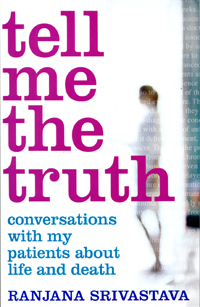Tell Me the Truth
 Tell me The Truth: conversations with my patients about life and death
Tell me The Truth: conversations with my patients about life and death
Author: Ranjana Srivastava
Publisher: Penguin/Viking, 2010
ISBN: 9780670074402
320pp
RRP $32.95
This is a rare book and the author is a rare physician. Ranjana Srivastava is an oncologist working in Melbourne. She questions what she does and how she does it and strives to relate to her patients and their families with honesty and compassion. The title of the book reflects what many patients ask of her.
The truth is often kept from patients by doctors who do not want to ‘burden’ them with the horrid details of their disease and the patient’s eventual death. Or the doctor goes along with the patient’s (often futile) hope that more surgery or another round of chemo- or radio-therapy will extend their life. Sometimes it may, but at what cost? And there is not just the financial cost (to the patient and to society) but the emotional cost as well. The author bemoans the fact that there is no adequate training (or none at all) for doctors to teach them how to talk with patients who have a disease that is likely to kill them soon. Many doctors avoid having to deal with the issue of death and dying, because they are trained to fight disease and prolong life.
What makes the author a rare physician is not just her questioning of what she does and why she does it (I’m sure other doctors do the same), but that she is willing to wrestle with the answers and with her conscience; and that she is willing to share these struggles with the reader.
Many of Ranjana Srivastava’s patients and the patients’ families have been generous in allowing her to include very personal stories in this book. The author is also generous in the sharing of her own journey as a doctor and as a mother. The book comprises a collection of stories about individual patients and about episodes in the author’s life which take the reader along as she increases her understanding of the doctor-patient relationship, the different ways in which patients and their families deal with cancer (the suspicion that something is wrong, the diagnosis, the prognosis and the treatment) and how they all deal with dying and death – and the way the author deals with these changes over time.
Because this is a collection of stand-alone pieces, the book can be read a bit at a time. Alternatively, reading it straight through allows the reader to accompany the author on her very personal journey. One of the issues the author struggles with is when to stop further medical intervention other than palliative care. When should someone be told that there is nothing more that the medical profession has to offer? Should the doctor agree to more chemotherapy when she is convinced that it won’t extend the person’s life and is likely to diminish their enjoyment of what is left of it? Is it possible to tell accurately how much time a person with cancer has to live? Does telling them how long you think they have to live influence the course of the disease?
This book is informative and reflective and highly personal. It is riveting reading with the potential to take many readers on an emotional rollercoaster. It also gives valuable insight into an aspect of medical practice and the struggles of one doctor in juggling the demands of a busy oncology practice, the needs of patients and their families and the call to share her humanity.
© 2011 Daan Spijer
[to receive an email each time a new review is posted, email me: <daan [dot] spijer [at] gmail [dot] com>]
 CLICK HERE to download a formatted PDF of the above post
CLICK HERE to download a formatted PDF of the above post
 See more of Daan Spijer’s writing and his photos at Seventh House Communications
See more of Daan Spijer’s writing and his photos at Seventh House Communications